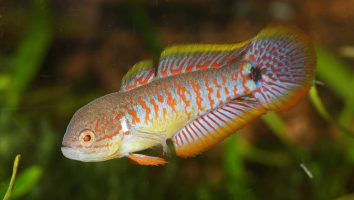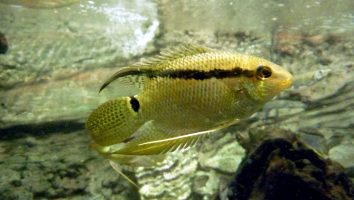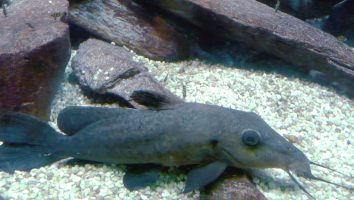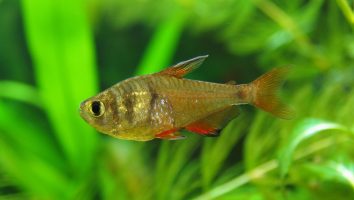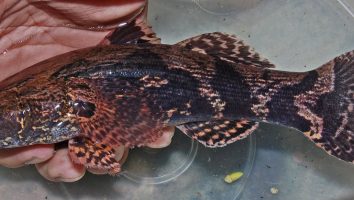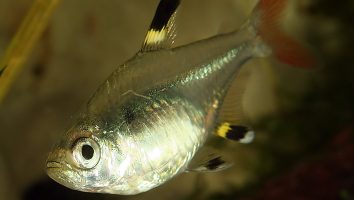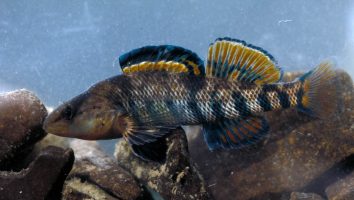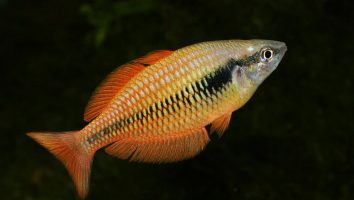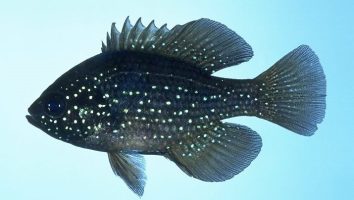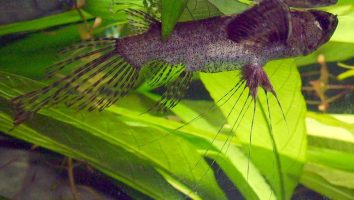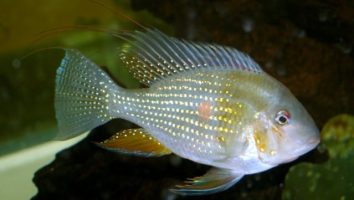The longear sunfish is a freshwater fish that is native to North America. It is a member of the centrarchidae family, which includes other popular sunfish such as the bluegill and the pumpkinseed.
The longear sunfish is a relatively small fish, usually only reaching lengths of around 6-8 inches. However, they can grow up to 12 inches in some cases.
They are easily recognizable by their long, pointed ear fins, which are much longer than those of other sunfish species. They also have a dark lateral stripe that runs along their body.
Table of contents
Species overview
Longear sunfish (Lepomis megalotis) are a type of freshwater fish that’s native to North America. They are most commonly found in the Mississippi River basin but have also been known to inhabit other river systems in the eastern United States.
Longear sunfish prefer slow-moving water with a lot of vegetation. This could be in the form of submerged plants or simply a lot of leaf litter on the bottom of the river.
They are relatively small fish, only reaching around 6 inches in length at most. Despite their small size, they are quite aggressive and have been known to fight with other fish of their own species.
Longear sunfish are popular among anglers because they are relatively easy to catch. They are also a popular choice for aquariums because of their bright colors and hardiness.
Appearance
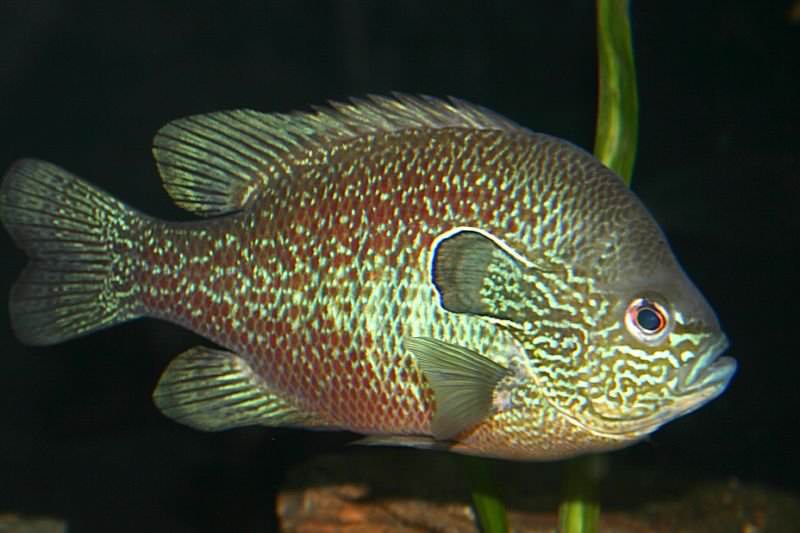
The most notable feature of the Longear Sunfish is the long extension of the operculum (ear flap) that hangs over their eye. This “ear” can be almost as long as the fish’s eye is wide!
Other than this, they have a very standard sunfish appearance. They have a fairly deep and compressed body with a small mouth that’s slightly tilted upwards.
The dorsal fin on these fish is short and rounded with 12-14 spines. The anal fin has 3 spines and is also rounded. Both of these fins have a dark border and a light center.
The pectoral fins are long and thin, while the pelvic fins are shorter and rounder. The caudal fin is forked and slightly rounded.
The coloration of the Longear Sunfish can vary quite a bit depending on the location they’re found. They can be brown, olive green, or yellowish on the upper half of their body. The sides are usually a lighter color with a mottled appearance.
The belly is usually white, and the fins are typically clear with a dark border.
Lifespan
The average lifespan of a longear sunfish is 4 to 6 years. However, they can live much longer in captivity.
One longear sunfish in particular, named “Grandad”, was kept in an aquarium at the Shedd Aquarium in Chicago. He lived to be 27 years old!
The secret to his longevity was great care and a diet of live foods.
Size
The average Longear sunfish size is 4-6 inches.
Tank
Tank Size
The recommended tank size for longear sunfish is 30 gallons. This is assuming you’re only keeping one fish, which is not recommended.
These fish do best in schools so you should aim for a tank that is at least 50 gallons if you want to keep a school of 5 or more fish.
As with most fish, the more space you can provide the better. These fish are very active and will often swim long distances in search of food or a mate.
Water Parameters
Longear sunfish are a fairly adaptable fish, which means they can withstand a wide range of water conditions. However, they prefer certain water conditions over others.
To keep your longear sunfish happy and healthy, aim for the following water parameters.
- Water temperature: 70 to 80 degrees Fahrenheit
- pH levels: 6.5 to 7.5
- Water hardness: 4 to 10 dGH
- Alkalinity Levels: 2-12 dKH
What To Put In Their Tank
When it comes to setting up the interior of their tank there are a few things you’ll need to take into consideration.
The first is that these fish like to have some hiding spots. This can be in the form of plants, rocks, or driftwood. Anything that gives them a place to hide away from the light will work.
The second thing to keep in mind is that these fish are known to be jumpers. A lot of times it’s because they’re startled, but it can also be because they’re looking for a way out.
You’ll need to make sure that your tank has a lid that’s secure. We recommend getting a glass lid since it will seal the tank better (preventing evaporation and keeping your fish in).
For the substrate, these fish don’t really have any preferences. You can use gravel, sand, or even go with a bare-bottom tank if you want.
Common Diseases
The longear sunfish is a hardy fish that doesn’t often fall ill. However, there are a few diseases that they are susceptible to.
The most common disease that affects this species is columnaris. This is a bacterial infection that can be quite serious if it’s not treated quickly.
The symptoms of columnaris include ulcers on the body, fin rot, and a cloudy appearance on the skin. If you notice any of these symptoms, it’s important to act fast and begin treatment immediately.
Another disease that can affect longear sunfish is gill flukes. This is a parasitic infection that is fairly common in freshwater fish.
The symptoms of gill flukes include heavy breathing, lethargy, and a loss of appetite. If you notice any of these symptoms, you should take your fish to the vet as soon as possible.
There are plenty of other potential diseases that could affect your longear sunfish, but these are the most common. As always, the best way to prevent your fish from getting sick is to maintain a clean and healthy tank.
Behavior & Temperament
Longear sunfish are peaceful fish that enjoy the company of others. They are schooling fish, so it’s best to keep them in groups of five or more. This will help them feel more comfortable and less stressed in their environment.
When it comes to their diet, longear sunfish are opportunistic feeders. This means they’ll eat just about anything they can find. In the wild, their diet consists of insects, small fish, and crustaceans. In captivity, they can be fed pellets, flakes, live, and frozen foods.
Longear sunfish are also known to be good jumpers. So, it’s important to have a tight-fitting lid on your aquarium to prevent them from escaping.
These fish are relatively active, so they need a tank that is at least 30 gallons. They also prefer tanks with plenty of hiding places and vegetation.
Tank Mates
The longear sunfish is a peaceful and gentle fish that can be kept with a wide variety of tank mates. They are not known to be aggressive or territorial and get along well with other fish that occupy the same water column.
Some good longear sunfish tank mates include:
Breeding
Longear sunfish breed in the spring. The males will build nests out of vegetation on the bottom of the pond. Then, the females will lay their eggs in the nests.
Males will aggressively defend their nests from other fish. So, it’s best to give each male plenty of space. If you have a smaller pond, you may need to remove some of the fish before breeding season.
To encourage spawning, you can do a partial water change a few weeks before breeding season. Then, stop feeding the fish for a few days. The hunger will trigger spawning.
When the eggs are ready to hatch, the males will move them to shallower waters. The fry will survive on their own after that. You don’t need to do anything special to care for them.
Conclusion
The longear sunfish is a great fish for beginners and experienced aquarium hobbyists alike. They’re relatively easy to care for and are very peaceful, making them a great addition to community tanks.
They’re also very pretty fish, with their long fins and bright colors.
If you’re looking for a fish that’s easy to care for and that will add some beauty to your tank, the longear sunfish is a great choice!

